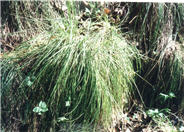Hotlinks:
| Designer: | Southwest Story |
Photographer: GardenSoft |
Soils and Compost:
Practice grass-cycling by leaving short grass clippings on lawns after mowing, so that nutrients and organic matter are returned to the soil.
Water Saving Tip:
Water-wise plants can be beautiful as well as practical.
Take your 'My List' Hydrozone Report to a landscape designer, or local nursery, when selecting and purchasing plants.
Integrated Pest Management:
Develop healthy soil for plants that are vigorous and naturally pest-resistant.









